Imagine being in a lush forest where two parallel paths are laid before your eyes. The one on the right has seemingly endless rows of torii (a type of gate usually found at Shinto shrines in Japan), and so does the left one, although peeking through the latter you realize that its curve makes it a somewhat more mysterious option. But do you really need to choose? You remember Alice in Wonderland; her curiosity to go down the rabbit hole brings her to a whimsical world where she meets outlandish and downright bizarre characters.
And have I mentioned the foxes? Not just regular foxes you see in the wild or those your cats are eager to shoo with their cute paws. These foxes are taller than you and they look fierce. Some of them even have something that looks like keys in their mouths. Not keys to gates or houses. No. They can open something more important, or so I am told. Something so precious for the Japanese it’s unthinkable, outrageous even, to imagine the country without it today.
Rice. The foxes are holding the keys to granaries where rice is stored. You and I and probably everyone we know might think that fish is the most important ingredient in sushi. But then you and I and probably everyone we know learn that rice is actually the centerpiece of any sushi. And of course sake. Imagining Japan without sake is tantamount to sushi without the rice. In the past, the long-lost, distant past, people might even have called such a thing “blasphemy”.
Now back to the two rabbit-hole-like pathways, both colored in bright vermilion, a color believed to ward off evil spirits – which you may find relieving for the foxes already make you feel uneasy. But that’s your brain trying to play a trick on you, for all the manga and anime that inspired you to come in the first place taught you that kitsune, the Japanese name for foxes, are in fact shape-shifters. I hope you’re not thinking of going back already because you actually haven’t made up your mind.
Right path? Or is it left?
Don’t worry. I’m telling you these things only because I’ve been there before, right where you’re standing now, feeling and thinking what your heart and brain are trying to tell you – or warn you.
Can you feel something pulling you now? That is probably Inari, the kami of rice and sake, also of agriculture and industry, a reminder of how Japan transformed its landscape from farmlands to factories. Inari is male, female and androgynous; a form of kami who themselves are the embodiment and expressions of spirits, elements of nature, beings and qualities in the Shinto universe. The foxes, I’m telling you now, hoping that you’ll feel at least a little bit more comfortable, are in fact Inari’s messengers. And as messengers do, they not only bring commandments, but also act as a means for humans to connect with the deities.
I chose the right path, just because I could see deeper and further. Maybe you’ll consider taking the same steps?
Come! Walk through those vermilion torii. See! It’s not as scary as you thought. And walk a little further. There! Do you see the two paths eventually merging into one? This isn’t called Senbon Torii (thousands of torii gates) for no reason. And as you can see, it’s not a labyrinth. It’s more like a guided trail that will bring you closer to Inari, figuratively speaking of course.
Now that you know there’s nothing to worry about at this place, I’ll let you wander around by yourself. Next time you see larger-than-life foxes, you know you should feel secure, not scared. And as long as you see vermilion, you know you’re good. Oh! one last thing. When you wake up from your dream, and you think others need to be here as well, do them a favor, will you? Tell them what I told you today. Explain to them about the torii, Inari, the foxes, the vermilion color, and the two pathways, the very place where you started this journey. Let the foxes and torii guide them through their own journey, their own vermilion dream.







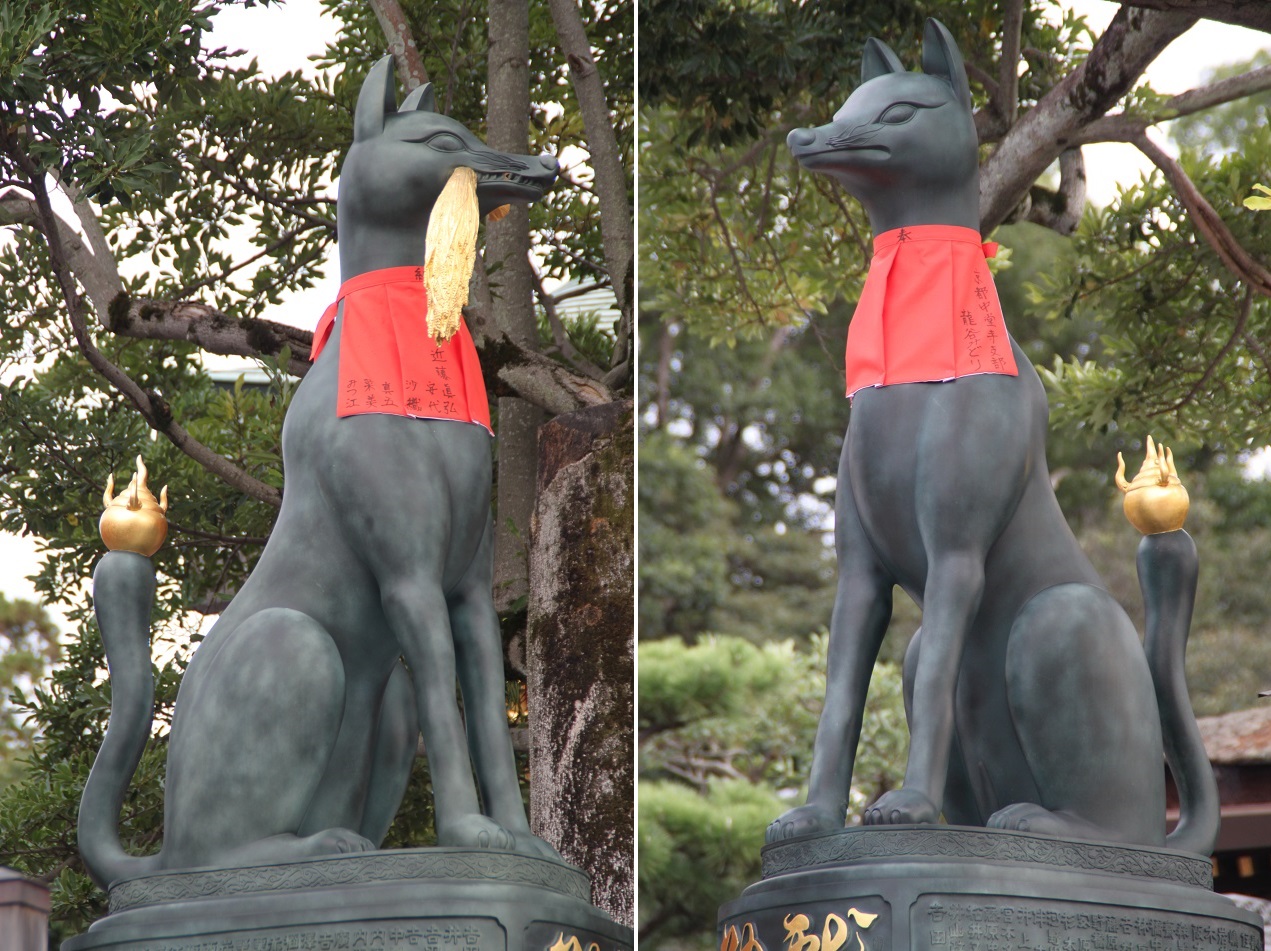


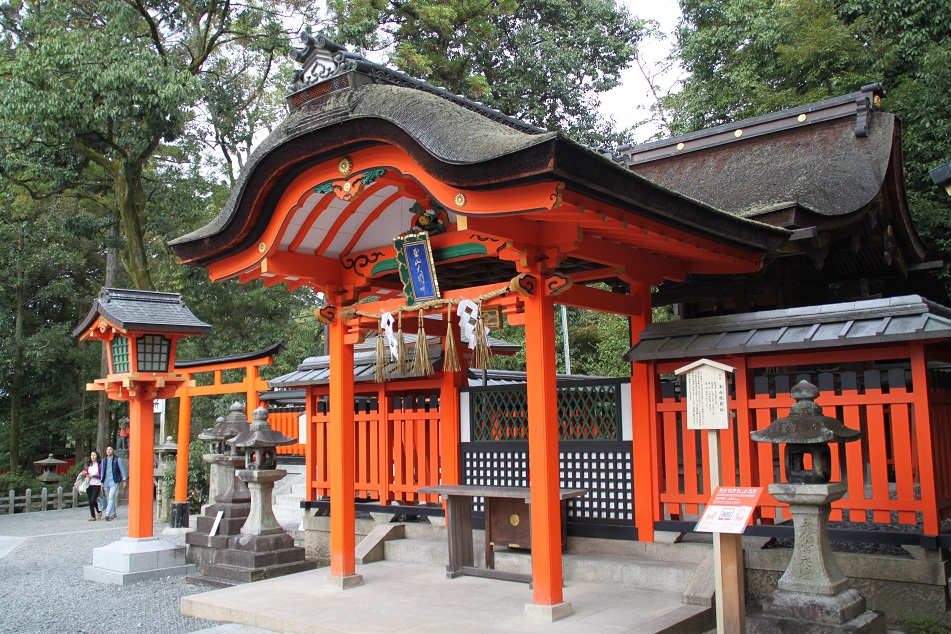

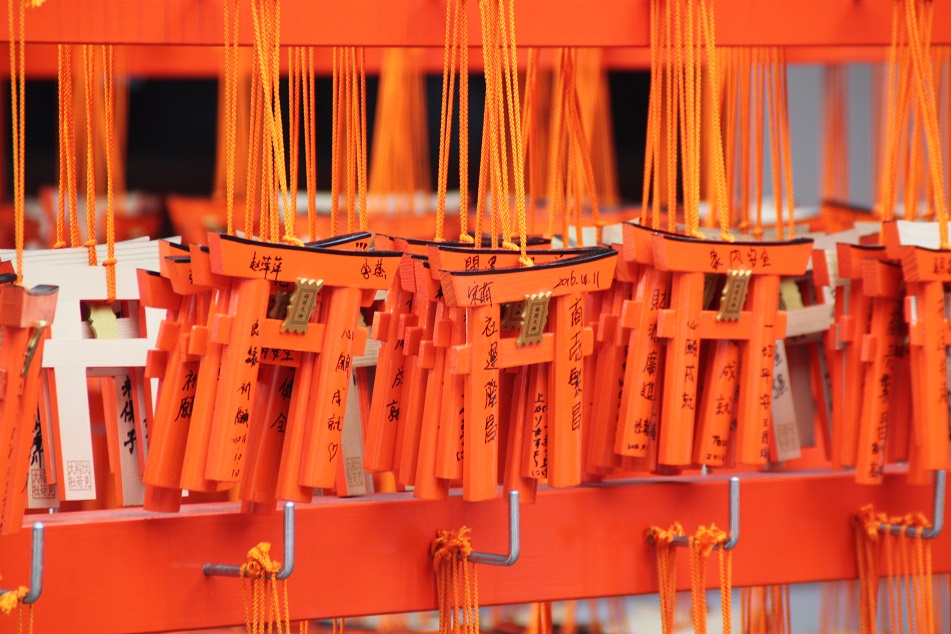
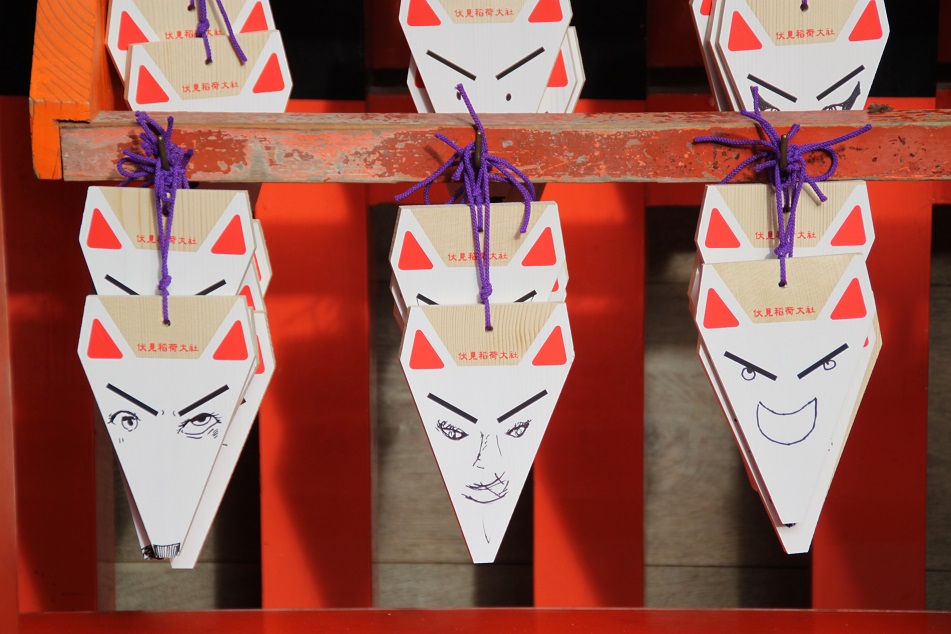
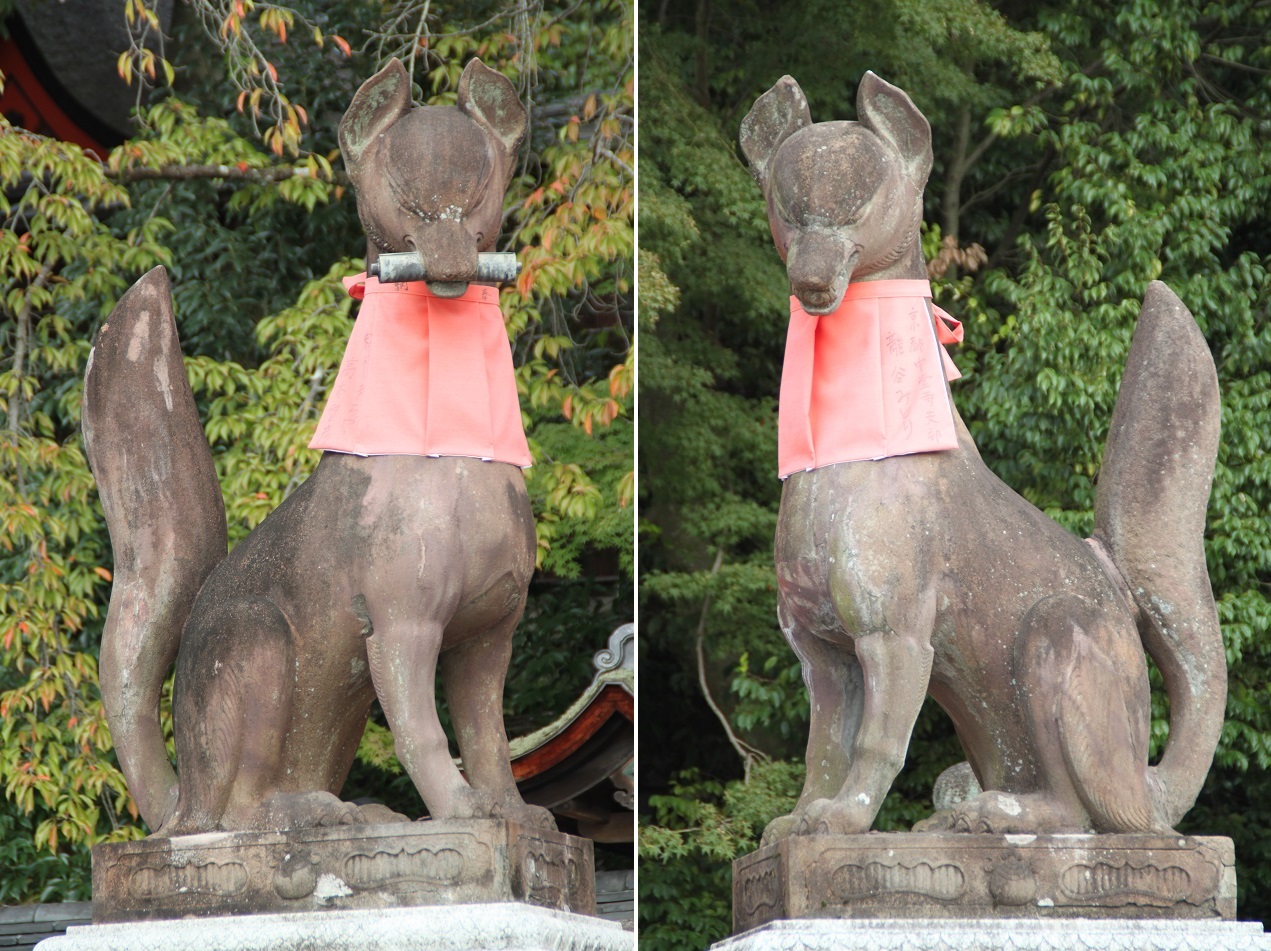
.. your coming there now (?)
立春大吉 day for sign of spring 🙂 nice post !
LikeLike
I really wish I were, but this is from a trip back in October 2016. Thanks for reading!
LikeLiked by 1 person
…I see ! Suppose being back to here again someday and re- discovering 🙂
LikeLike
I would love to go back to Japan and explore more! Hopefully sooner than later.
LikeLiked by 1 person
wow, this is stunning. i’d love to see a shinto shrine in person –
LikeLiked by 1 person
You really should, Beth, as Shinto is unique to Japan. One recurring theme of the religion based on my observation is its emphasis on balancing humans with nature and the past, displayed in elegant simplicity.
LikeLiked by 1 person
I have loved their philosophy and approach for a long time –
LikeLike
The way they see the world is very fascinating, isn’t it?
LikeLiked by 1 person
A Kitsune was a character in a really ridiculous book by Tom Robbins called Villa Incognita. I don’t really recommend to read it, but that is what I know it from. I think I like your temple better.
How long is the trail with the gates? That looks absolutely incredible, and of course very Instagram worthy. I could see it being clogged with tourists getting the perfect selfie!
Thanks for taking us on the journey.
LikeLiked by 2 people
I wonder if that character has anything to do with a fox?
Thanks to the dense torii gates at Senbon Torii, the trail looks really long indeed. But it really wasn’t — unless the rest of the trail going up to the hilltop where there are less torii gates was taken into account.
Thanks for reading, Jeff!
LikeLiked by 1 person
A fascinating read! The place sounds amazing and mysterious! Thanks for a good journey!
LikeLiked by 1 person
Thanks Soorya! Fushimi Inari Taisha has become one of the most popular places in Kyoto, and this was evident during my visit back in 2017. Most people were more interested in getting their photos taken with those bright vermilion torii gates, though. Patience and a little imagination are what you need to enjoy this shrine these days.
LikeLike
yes right
LikeLike
That was an amazing journey into Japanese sensibility, the folklore, the way-of-life and the recent transformation the country has witnessed. The presentation immediately sets the tone and aura for the exalted subject in focus.
LikeLike
Much appreciated! I mentioned to another reader that today this place has become very popular among tourists. But that doesn’t mean you can’t enjoy the ambiance of this part of the ancient Japanese capital.
LikeLiked by 1 person
Hello,
nice place to discover. Thank’s for your article.
LikeLike
Ah merci Richard! Thank you for reading.
LikeLike
Damn..these pics are really good and so is the place your pics are so spectacular
that even by looking at it I feel like going there
LikeLike
Thanks for your kind words! Since no one has successfully invented teleportation machine, at least for now blog posts will do? 🙂
LikeLike
Hehe
LikeLike
Follow my blog too
LikeLike
Enjoyed the way you presented Fushimi-Inari. I’ve been before, but still felt like I was right there with you in that dream!
LikeLiked by 2 people
Much appreciated, Celia! I was there with hundreds of other visitors. I can imagine how magical and atmospheric Fushimi Inari Shrine must be when tourists have left.
LikeLiked by 1 person
Bama, I have to say that this is one of my favorite posts you’ve done so far – and not just because of the striking vermilion in so many of the photos, but especially your immersive style of writing that weaves together Shinto beliefs, anime, and what I can only describe as a dream sequence. I have never read a blog post that captures Fushimi Inari in such a compelling way. Well done!
LikeLiked by 1 person
Wow, thanks a lot, James! I was experimenting with a different writing style, which fortunately worked well, I guess? To me Fushimi Inari Taisha is one of those places that inspire people to dream and write, and invigorate people’s imagination. Even with that many people, I still enjoyed my time there.
LikeLiked by 1 person
Really liked your experiment, Bama, very immediate and insightful but not scholarly, if you see what I mean. I visited Fushimi Inari’s temple twice, once in 2009 after having sat a course on anthropology where, of all things, Inari’s cult was heavily featured. It was quite an interesting thing and it made a great deal of difference, in terms of understanding, for me to be able to know what was going on in the sanctuary whilst I visited it. I wished I could understand more of the other temples as well, but alas that’s not yet the case.
Fabrizio
LikeLiked by 1 person
Thanks Fabrizio! Ideally I would love to do the same thing; learning about the history and philosophy of a historical place, and understanding the belief and perspective of the locals in relation with why and how it was built would certainly make the visit even more meaningful. But when I don’t have the luxury to do that, I turn to the internet to look for information from reliable sources quite easily. However, nothing beats in-class courses where questions can be asked right away and dialogues can develop very quickly.
LikeLiked by 1 person
Beautiful photos of a very colorful place! When my husband and I visited, it was pouring rain so we didn’t make it to the very top.
LikeLiked by 1 person
There must have been less tourists when you visited then, which now makes me wonder how this shrine looks like in the rain. Thanks for reading and sharing your experience, Katherine!
LikeLiked by 1 person
Very nice. In April I will be going to Kyoto for my second visit. My first visit was really rushed and I hope this second visit will let me spend more time here.
LikeLike
Ahh, how nice that you’ll be in Japan during the cherry blossom season! Hope you’ll enjoy your second time to Kyoto better than your first, Edwin.
LikeLiked by 1 person
This is awesome I am so glad I found this post! I loved the story and the pictures are amazing!
LikeLike
Much appreciated, Myra! Glad you enjoyed this as much as I did writing it since this is not how I usually write my posts.
LikeLiked by 1 person
Oh this is so wonderful Bama. I enjoyed your story telling of the foxes and the inari. I will be in this place in May. Can’t wait!
Alison
LikeLike
Thanks Alison! It’s so nice that in a few months’ time you’ll be visiting Kyoto! Hope the crowd won’t be too overwhelming, though. I remember when I was in Japan back in October 2016 I was in Okayama during a school holiday. There were a lot of Japanese visitors to a local castle, but being Japan, the crowd moved in a very orderly manner so much so it was actually fun being surrounded by that many polite people.
LikeLiked by 1 person
Mas Bamaaaaaa… aku suka sekali dengan post ini. Gayanya sangat berbeda dan menarik sekali, seperti aku didalamnya hahaha dan aku juga ambil jalur kanan. Dan tentu saja foto-fotonya mas Bama selalu warbyasah 😆
By the way, nyngguin lorong kosong berapa lama mas? Terakhir aku kesana… sampai bosen aku nunggu orang datang terus… pasrah deh.
LikeLike
Makasih Mbak Riyanti. Pas nulis ini saya sebenernya agak-agak terinspirasi sama salah satu adegan di film The Matrix dimana Neo harus pilih antara pil merah atau pil biru yang disodorkan Morpheus. 🙂
Hmm, gak terlalu lama sih seinget saya. Memang waktu itu rame banget. Tapi tiap beberapa menit sekali seperti ada jeda beberapa detik dimana manusia gak kelihatan sama sekali di lorong-lorong itu.
LikeLike
I love the way you’ve beckoned us in here, Bama! Of course, I could guess what was coming because I knew the names, but it was still a thrill to read about the symbolism and your own feelings of anticipation as you entered. I like your new (or at least one-time!) storytelling style!
LikeLike
Thanks Lex! This was an experiment, and honestly it was so much fun to write. I was just in the right mood and at the right time when I wrote this post. But I don’t know how often I can write like this, or in other writing styles. Glad you enjoyed this!
LikeLiked by 1 person
You’re making me think seriously about visiting Japan again
LikeLike
And you know you won’t regret it, don’t you?
LikeLiked by 1 person
Wonderful creative writing and of course super photos!
LikeLike
Thanks Marilyn! I know my posts can sometimes be too heavy on history. This post is me trying to present a foreign culture in a lighter way.
LikeLiked by 1 person
It worked!
LikeLiked by 1 person
Bama, you had me captivated by your story of pathways, foxes, rice…It is so much more interesting looking at your photos with this intriguing preamble. The vermilion paths really are stunning. I know so little about Shintoism; thank you for introducing me. You’ve put Japan even higher on my travel list.
LikeLike
Much appreciated, Caroline! You really should go to Japan as it is probably the only country where everyone I know who has been has nothing bad to say about it. They all loved Japan for different reasons, and I’m sure there are aspects of the country that you will find fascinating, refreshing and inspiring.
LikeLike
It has long been a dream of mine to take this vermilion journey and your post makes me even more eager to make it a reality.
LikeLike
Despite its popularity today, Fushimi Inari Taisha is still worth a visit. And if you prefer a quieter ambiance, maybe you can try going there early in the morning. I was there in the afternoon, though.
LikeLiked by 1 person
You write beautifully – it’s usually photos that make me imagine what it’s like to be there, but this time it was the writing 🙂 I love that even the foxes are wearing red – it has an incredible effect
LikeLike
Thank you, Jess! All the positive feedback I got really makes me think if I should write something like this more often in the future. We’ll see about that as ideas don’t always come easily. 🙂
LikeLiked by 1 person
I love your story, Bama. And I’ll never tire of seeing this place! What an exceptional post, and your final words are a bit serendipitous for me and an idea I’m working on. Hopefully someday I’ll have the chance to explain!
LikeLike
Thanks Kelly! Now I’m really intrigued by whatever it is that you’re working on right now. Speaking of serendipity, I’m really looking forward to that day when we serendipitously bump into each other in whichever part of the world!
LikeLiked by 1 person
Yes! Yes! Yes! I can’t wait for that day Bama!
LikeLiked by 1 person
Beautiful
LikeLike
Fushimi Inari Shrine really is among the prettiest temples in Kyoto. Thanks for reading!
LikeLiked by 1 person
I love the moment of solitude you had along the path of endless vermillion Torii. A rare treat when among so many visitors.
LikeLike
Indeed, I had to wait for an endless stream of visitors to walk far enough to disappear at the other end of the pathway. After all this kind of place is better enjoyed with patience.
LikeLiked by 1 person
Awesome post man, so pretty.
LikeLike
Thanks Brett! Glad you enjoyed this post.
LikeLiked by 1 person
Japan, and Kyoto in particular, is my dream. Thank you for such a mysterious story. The pictures are great.
LikeLike
Hope you’ll get there sooner than later, Victor. Thanks for reading!
LikeLiked by 1 person
Thank you for that magical journey into a vermilion dream Bama! Have to agree with James, this is the most captivating post on Fushimi Inari that I have read too. And one of your best. Your creative narration, that lures in even those familiar with this shrine and its many legends, trumps your fabulous photos. Great job.
LikeLike
As someone who has been following this blog for years, your words really are encouraging, Madhu! I need to find a way to bring my mind back to the mood of that night when I wrote this post. But for the time being, there will be more posts written in my usual style than those like this one on Fushimi Inari Shrine. I really appreciate your kind words, Madhu!
LikeLiked by 1 person
Interesting! I didn’t know that the fox god and goddess was so important in Japanese culture. In our culture (and I think in China as well), the fox is associated with intelligence, but somehow trickery. How about yours? Does the fox appear in Indonesian culture as well?
Excellent photos as always! Maybe I should turn right as you did in order to capture the Torrii without any human 🙂
LikeLike
I don’t recall any story about fox in Indonesia — there might be though. Instead, here mouse-deer is the animal often associated with intelligence. Ha! The truth is there were as many people on the right side as there were on the left. It was a particularly busy day for the shrine. Thanks Len!
LikeLiked by 1 person
You were in Japan? I love Kyoto but hate of how touristy the city is. I went to Fushimi Inari during spring break and goodness, in each step I take there’s always someone taking selfies, man. But I love the temples in Kyoto and Osaka. You should visit Japan during summer where there are festivals and parades like every week!
LikeLike
I was in Japan for about eight days in autumn back in 2016, but the stories from that trip are coming really slowly. There were indeed a lot of tourists in Kyoto, and I can imagine there must be even more in summer. Actually I’m planning to go back to Japan in winter since my best friend raved about how soft and powdery the snow was when he went. But we’ll see; nothing is fixed until I book the flights!
LikeLike
Ah then I believe the Sapporo Ice Festival is the perfect time to go for winter holiday in Japan! But of course this would be very crowded as well, so you might wanna opt for other places as well if you prefer a quieter area.
LikeLike
Either that or probably Nagano, although I know the latter is also quite popular now. However, my experience with Japanese crowd was actually far from being unpleasant. I was in Okayama during a national holiday, hence the large number of domestic tourists around the city’s castle. I was surprised to see how orderly the Japanese were, no jostling whatsoever.
LikeLike
So I’m guessing you never board the train here during the rush hour…😏
LikeLike
Ahhh… Yes, that’s quite legendary. Is it only in Tokyo or that’s also the case in other big cities?
LikeLike
Not sure, but I wouldn’t be surprised if that is indeed the case. Osaka is just as crowded so their rush hour might be just as crazy and hectic like in Tokyo. (Just avoid Shinagawa and Shinjuku station at all cost.)
LikeLike
Well noted. Thanks for the info!
LikeLike
I’ll be going to Kyoto in April this year 😀 Can’t wait to see this beauty.
LikeLike
Ahh April is cherry blossom season. Hope you’ll experience Kyoto with all of its past glory and present beauty!
LikeLiked by 1 person
Nice one there senior.
Following your footsteps
LikeLike
Thanks George. Glad this post brought you to that vermilion dream I imagined! 🙂
LikeLike
You are welcome senior
LikeLike
You have a fascinating blog. Congratulations
LikeLike
For some reason your comment ended up in my spam folder. Glad I checked! Thanks for reading, Denzil!
LikeLike
The vermilion inspired me to click on this post, and I found myself mesmerized. The journey, the message, and, mostly, the foxes. There is so much personal significance in all of this, I can’t help but feel it’s more than a coincidence that I happened upon it at this very moment. Thank you, Bama.
LikeLike
Thanks Julie! It’s been really encouraging to read all the comments on this post since, as you might notice, I departed from my usual writing style. This makes me want to go back to Japan to be inspired and enchanted again by that fascinating land.
LikeLike
Pingback: A Pilgrimage to Purity | What an Amazing World!
Pingback: Kyoto Sanctuaries: Yasaka Shrine and Chion-in | What an Amazing World!
Amazing colors but I remember these shrines are not that old.
LikeLike
What I know is the main shrine itself is old, but some of the vermilion gates are not as they’re donated by people from time to time. So it’s very likely that ten years from now there will be even more of such gates on the hill where Fushimi Inari-taisha is located.
LikeLiked by 1 person
Pingback: Buddhist Treasures Beneath A Rock | What an Amazing World!
I hope one day to stand at the fork in the path of the torri and choose for myself which route to take. In the meantime thank you for leading us so beautifully through this torri and for your beautiful photographs.
LikeLike
Whichever way you choose, just listen to the foxes. 🙂 Hope you’ll get the chance to visit Kyoto sooner than later, Suzanne. And thanks for your lovely comment.
LikeLike
Excellent photos as always Bama, and the perfect accompaniment for your evocative post. This shrine must be one of the most photogenic in Japan. And I’m not sure how you managed to get such great photos of the torii gates with no people; good luck and patience I guess. When we visited the crowds were crazy, but we went expecting that so it wasn’t too bad. After all, I was one of those annoying tourists taking photos as well.
And I love your title. It’s absolutely perfect for this shrine. The Shinto use of color is marvelous.
LikeLiked by 1 person
Thank you, James. I think I waited quite a long time to get that shot. When I saw an opportunity to take a photo of the torii gates without people in it, I immediately went to that particular corner. But these days, most of the time I actually don’t mind having people in my photos, because I know I must be in some of their photos too.
LikeLiked by 1 person